Maker - Syn (Erle Bartlett) synwhistles@yahoo.com.au
Material - Aluminum Body with Delrin and Brass Head
Dimensions: Length - 22 5/16ths" (with head pushed all the way in)
Distance between 1st and 3rd bottom holes - 2 15/16ths"
Distance between 1st and 2nd bottom holes - 1 7/8ths"
Diameter of 2nd hole from bottom - 7/16ths"
Bore - 7/8ths"
Weight - 8 oz
Price at time of review - $180 US direct from Maker. Mr. Bartlett does not currently have his own business website, but you can contact him directly via email. Otherwise, this whistle is available through the following distributors: Big Whistle, Gaelic Crossings, and Oz Whistles.
Now
that I have been doing this review thing for a little while (and I
haven't been run out of town...yet), I've started to be contacted by a
few whistle makers requesting that I review their low whistles. (Which
is a good thing, because if I bought one more whistle, my wife was
going to stick it where...well, you know) Such is the case with Erle
Bartlett, well known maker of the Syn and Black Diamond line of
whistles from Australia, who very kindly let me borrow one of his Syn
Low D's to try out for a few days.
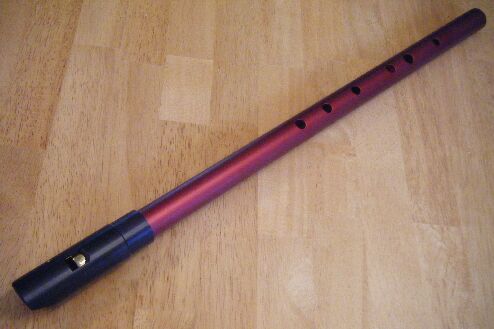
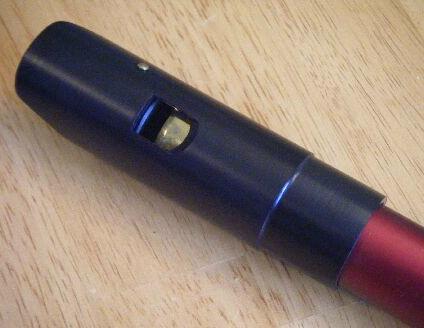
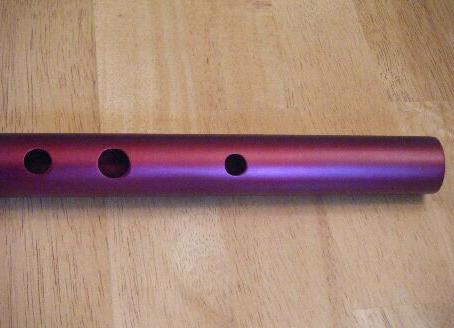
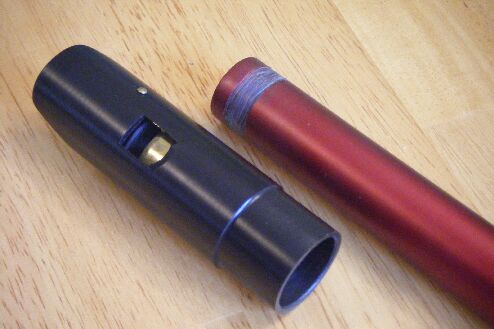
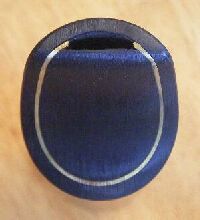
Appearance:
At first glance this whistle somewhat resembles a Howard, both having a
large, black head. Closer examination however shows many key
differences in both construction and material (A Howard has an ABS
plastic head and brass body, where the Syn has a Delrin head and
aluminum body). I actually stayed away from this whistle at first as
red is not one of my favorite colors, and I was hoping that they might
come out with some other color options. But I have to say that far from
being fire engine red, this whistle has a very attractive soft, deep,
and warm wine red anodized body (I was unfortunately unable to
capture this well in the photos, which make it look more purple). The head/blade has a very interesting
construction. Most whistles use either the edge of the body or the head
itself to construct the blade, but on this whistle Mr. Bartlett has
inserted a thin brass sheet between the outer Delrin head sheath
and Delrin plug to form the
blade (You can see this in the picture of the top of the head above).
One of my favorite features of this whistle is that the head pops on
and off the body very easily, but is by no means lose when it is on,
and does not appear to have any air leakage issues. The mouth piece is
nicely shaped, smooth and comfortable. It also came in a thin corduroy bag perfectly sized to fit.
Tone: Another characteristic this whistle shares with a Howard is a slightly nasal, reedy tone. While it has a very little/slight amount of breathiness, it still has a very complex sound, even through the second octave. Pretty high amount of chiff as well.
Volume: I would describe the volume of this whistle as being moderate to low in comparison to other Low D's I have played. The second octave is noticeably louder than the first, due to the issue stated below. Probably not a good session whistle volume wise.
Backpressure/air requirement: This whistle has a pretty high amount of backpressure, which does make for a relatively low air/breath requirement on the bottom octave. However, one does have to either blow pretty hard or preferably concentrate on tightening ones embouchure in order to keep the notes in the second octave from breaking back down into the first, which can give the second octave a somewhat higher air requirement. I found that this issue made it somewhat difficult to cleanly play dance tunes that jump between octaves allot or quickly. However, as with most whistles, I'm sure this would cease to be an issue once one became acclimated/accustomed to it's embrochure/air requirements. It was also difficult to tell if this was due to clogging or just a regular feature of the whistle.
Responsiveness: Ornaments can be executed without any trouble, but can sometimes feel just slightly sluggish.
Clogging: I was actually warned ahead of time by both an owner and the maker that this whistle needed to be warmed up before playing due to it's thick delrin head. Luckily, as previously mentioned, the head is easily removable and can be held in ones hand, other strategically warm body part (keeping in mind you have to put it in your mouth when your done!), or even blown into for a quick warm up. Otherwise, the whistle can clog very easily causing it to sound fuzzy and generally wrecking havoc with notes breaking right and left.
Tuning: The whole whistle seemed to be pretty well in tune, with the exception of the high B, which was 20 cents flat. The C natural is good with the OXXXOO fingering.
Sound clip: I was inspired by the tone of this whistle to play a rousing rendition of Amazing Grace.
Summary: Once you get it warmed up so that it will stop clogging, and once you get a feel for how it wants to be played embrochure/air requirement wise, this is actually quite the pleasant sounding and playing whistle. Mr. Bartlett told me that "My design brief was to make a low whistle that is light, attractive, tunable and with high backpressure and air requirements that make playing it more like a high whistle, especially in being able to play long phrases", and I think three out of four ain't bad! (Coming in at 8oz, it is slightly heavier than what I have found to be the average weight of low D's, 7oz)
Four holes.

Tone: Another characteristic this whistle shares with a Howard is a slightly nasal, reedy tone. While it has a very little/slight amount of breathiness, it still has a very complex sound, even through the second octave. Pretty high amount of chiff as well.
Volume: I would describe the volume of this whistle as being moderate to low in comparison to other Low D's I have played. The second octave is noticeably louder than the first, due to the issue stated below. Probably not a good session whistle volume wise.
Backpressure/air requirement: This whistle has a pretty high amount of backpressure, which does make for a relatively low air/breath requirement on the bottom octave. However, one does have to either blow pretty hard or preferably concentrate on tightening ones embouchure in order to keep the notes in the second octave from breaking back down into the first, which can give the second octave a somewhat higher air requirement. I found that this issue made it somewhat difficult to cleanly play dance tunes that jump between octaves allot or quickly. However, as with most whistles, I'm sure this would cease to be an issue once one became acclimated/accustomed to it's embrochure/air requirements. It was also difficult to tell if this was due to clogging or just a regular feature of the whistle.
Responsiveness: Ornaments can be executed without any trouble, but can sometimes feel just slightly sluggish.
Clogging: I was actually warned ahead of time by both an owner and the maker that this whistle needed to be warmed up before playing due to it's thick delrin head. Luckily, as previously mentioned, the head is easily removable and can be held in ones hand, other strategically warm body part (keeping in mind you have to put it in your mouth when your done!), or even blown into for a quick warm up. Otherwise, the whistle can clog very easily causing it to sound fuzzy and generally wrecking havoc with notes breaking right and left.
Tuning: The whole whistle seemed to be pretty well in tune, with the exception of the high B, which was 20 cents flat. The C natural is good with the OXXXOO fingering.
Sound clip: I was inspired by the tone of this whistle to play a rousing rendition of Amazing Grace.
Summary: Once you get it warmed up so that it will stop clogging, and once you get a feel for how it wants to be played embrochure/air requirement wise, this is actually quite the pleasant sounding and playing whistle. Mr. Bartlett told me that "My design brief was to make a low whistle that is light, attractive, tunable and with high backpressure and air requirements that make playing it more like a high whistle, especially in being able to play long phrases", and I think three out of four ain't bad! (Coming in at 8oz, it is slightly heavier than what I have found to be the average weight of low D's, 7oz)
Four holes.